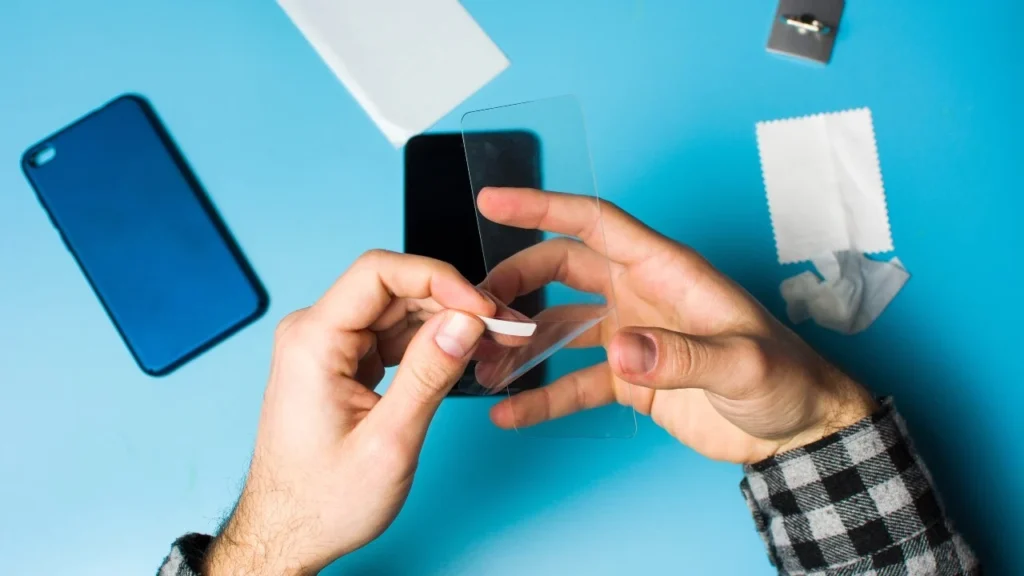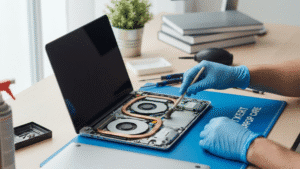Phone screen protectors, particularly those made of tempered glass or durable plastic materials, can help conceal minor scratches on your phone’s screen. While they don’t technically “hide” scratches, they serve as a protective layer that covers the surface of the screen, thereby minimizing the visibility of existing scratches and preventing new ones from forming. Here’s how phone screen protectors achieve this:

Smooth Surface:
- Screen protectors typically have a smooth and even surface that helps to fill in and mask shallow scratches on the phone’s screen. When applied correctly, the protector creates a uniform layer over the screen, effectively blending in with the surface and reducing the appearance of imperfections.
Optical Clarity:
- High-quality screen protectors are engineered to maintain optical clarity, ensuring that the display remains sharp, vibrant, and clear. By preserving the visual integrity of the screen, the protector minimizes the distortion or magnification of scratches, making them less noticeable to the naked eye.
Scratch-Resistant Coating:
- Many screen protectors feature scratch-resistant coatings that enhance their durability and resilience against scratches, scuffs, and abrasions. These coatings provide an additional barrier of protection for the underlying screen, shielding it from damage and preserving its pristine appearance.
Filling Microscopic Gaps:
- When applied to the screen, screen protectors adhere tightly to the surface, filling in microscopic gaps and irregularities that may be present. This helps to smooth out the surface and reduce the visibility of minor scratches, giving the screen a more uniform and polished appearance.
Preventing New Damage:
- In addition to concealing existing scratches, screen protectors serve as a proactive measure to prevent new damage from occurring. They act as a sacrificial layer that absorbs impact and absorbs scratches, preserving the integrity of the underlying screen and extending its lifespan.
It’s important to note that while screen protectors can effectively mask minor scratches and provide an additional layer of protection for your phone’s screen, they may not be able to eliminate deeper or more severe scratches. In such cases, replacing the screen protector or seeking professional repair may be necessary to restore the screen to its original condition. Additionally, regular maintenance and care, such as keeping your phone away from abrasive materials and cleaning the screen regularly, can help minimize the risk of scratches and maintain its appearance over time.
Screen Protectors
Phone screen protectors are an essential accessory for many smartphone users, offering an additional layer of defense against scratches, cracks, and other damage. But how exactly do these thin films manage to hide scratches and protect the underlying screen? To understand this, let’s delve into the science behind screen protectors and their mechanisms for concealing scratches.
Firstly, it’s important to note that screen protectors are typically made from materials like tempered glass or flexible plastics such as polyurethane or polyethylene terephthalate (PET). These materials are designed to be highly transparent, allowing light to pass through with minimal distortion. When applied to a smartphone screen, they effectively serve as a sacrificial barrier, absorbing the brunt of impacts and scratches that would otherwise damage the screen underneath.
One way screen protectors hide scratches is through their inherent design. The surface of a screen protector is usually smoother and more uniform than that of a smartphone screen. When a scratch occurs on the screen protector, it may not penetrate as deeply as it would on the unprotected screen. Instead, the scratch may be shallower and less noticeable due to the smoother surface of the protector. Additionally, the material properties of the protector, such as its hardness and flexibility, can help distribute the force of an impact or scratch, minimizing the visible damage.
Moreover, screen protectors often come with coatings that further enhance their scratch-hiding capabilities. For example, some protectors feature oleophobic coatings, which repel oils and fingerprints, making scratches and smudges less noticeable. Anti-glare coatings can also help diffuse light, reducing glare and reflections that might otherwise accentuate scratches.
Another factor to consider is the thickness of the screen protector. Thicker protectors, such as those made from tempered glass, can provide more substantial protection against scratches and impacts. Additionally, their thicker construction may help to mask minor scratches by filling in the gaps between the scratch and the underlying screen.
In some cases, screen protectors may also incorporate self-healing technologies. These advanced protectors contain materials that can repair minor scratches over time. When exposed to heat or pressure, the material can revert to its original state, effectively “healing” the scratch and restoring the protector’s smooth surface.
Reviving devices, one repair at a time! ???????? Trust Digimob for all your mobile needs! www.digimob.com.au
Overall, while screen protectors may not eliminate the risk of scratches, they serve as an effective deterrent and can significantly reduce the visibility of minor damage. By employing a combination of design, materials, coatings, and technologies, screen protectors offer an invaluable layer of defense for smartphone screens, helping to preserve their appearance and functionality over time.

Learn More: How To Check If Your iPhone Battery is Original?


